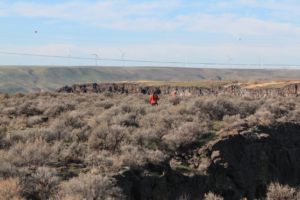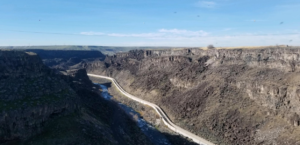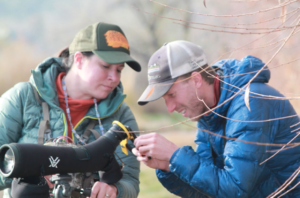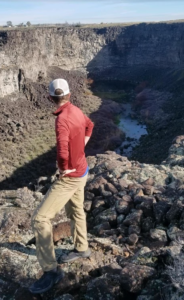Throughout the Magic Valley, a series of recreational destinations create Thousand Springs State Park providing hikers, picnickers, hunters, outdoor enthusiasts, and anglers opportunities to embrace the natural world.
After spending a morning bird watching in Hagerman Wildlife Management Area, ICL staff decided to make the short drive to Thousand Springs State Park’s Malad Gorge to explore this easy-to-access geological masterpiece.
High in the Sawtooth Range, the Big Wood River begins its 129-mile journey south, toward the Snake River, running almost parallel to the 90-mile Little Wood River that starts deep in the Pioneer Mountains. As these rivers flow out of the mountains, they travel through some of Idaho’s most important agricultural areas. When the rivers enter Gooding, they unite, creating one of the Snake River’s many tributaries – the 12 miles long Malad River. From Gooding, the Malad passes an array of agricultural farms and then makes its way through Thousand Springs State Park’s Malad Gorge and enters the Snake River.

Upon entering the Park, we were greeted by neverending vistas of grasslands and crops with the Gorge nowhere in sight. Our first stop in the Park was by means of a 150 ft. footbridge where the Malad River was meandering below us through the black and grey swirled basalt-lined gorge. We watched multiple bird species fly within the gorge, landing amongst the vegetation at the bottom that lined numerous pools of water.
Once we stepped off the bridge and onto the other side, we found ourselves standing on a finger of the gorge that runs parallel to the river. There were close to 200 ft. drops surrounding us, creating an island-like feeling of seclusion from the rest of the Park. We began making our way across the finger, amazed that this massive gorge is so easily hidden to those making their way across southern Idaho. Surrounding us was sagebrush and lichen-covered rock. We found ourselves stepping over fractures in the basalt that slightly took our breath away. The walk was easy, beautiful, surprising, and throughout, we maintained a healthy respect for the height surrounding us. When the desert island we stood on came to an end, we could see the river leaving the powerhouse through the last section of this zigzagging gorge and into the Snake River.

As we made our way back to the bridge, we passed a family of four heading out on their adventure, reminding us that this is an excellent destination for everyone. We ended the day by heading to the Park’s shaded picnic area to reminisce and laugh at the occasional adrenaline rush we each felt as we stood high above the water.

The Malad River is rich in history, consisting of stories about trappers, bandits, and pioneers on the Oregon Trail. The rivers that create the Malad River provide life to hundreds of miles of land, agriculture, and wildlife. In its short span, the Malad River feeds the Snake River that creates much of southern Idaho’s identity.

In ICL’s third annual Magic Valley Groundwater Report, we found that springs in the Magic Valley have elevated amounts of phosphorus, likely due to agricultural activities in the area. The Snake River Watershed provides drinking water to hundreds of thousands of Idahoans, water for agriculture, recreation, and wildlife. If contamination and mismanagement continue, our community’s drinking water can be negatively impacted and potentially affect the wildlife that depends on areas such as Malad Gorge. Join us and demand that local, state, and federal policymakers restore water quality in the Snake River and the surrounding aquifer.
